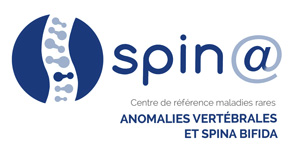Care pathways and paediatric care
Physical Medicine and Rehabilitation (PM&R)
The paediatric PM&R department’s expertise in spinal cord disorders has been developed over several decades through multidisciplinary consultations. These bring together the various professionals involved in the patient’s care: PM&R doctor, neurosurgeon, orthopaedic surgeon and visceral surgeon. These enable all the problems associated with dysraphism to be addressed. These common responses make it possible to provide the families concerned with objectives and a clear pathway.
Management of vertebral malformations: specific characteristics of the Orthopaedic Care Pathway
Prior to birth, an ante-natal consultation is organised with the orthopaedic surgeon. The orthopaedic surgeon will explain the orthopaedic aspect of the vertebral deformity and its care. He or she will also explain how the condition will be managed after birth: follow-up consultations, the need for various imaging exams, continued monitoring throughout the child’s growth, and any treatment that may be required. After birth, an orthopaedic consultation is organised within the first few months, best around the age of 6 months. During this appointment, an X-ray of the spine is performed, with the child lying face up and in profile. This is used to identify any bone abnormalities that may have been present before birth.
Depending on any associated spinal deformities, a CT scan or a MRI may be required during the first year.
Thereafter, follow-up visits are organised at regular intervals of 6 months or 1 year. This enables the child’s growth to be monitored and any worsening of the spinal deformity to be detected.
Usually no particular precautions need to be taken between two consultations.
Thereafter, depending on the child’s progress (learning to walk and run, taking part in various physical and sporting activities), the usual counselling is given to the child and his parents at the consultation.
As the child grows, if a progressive deformity of the spine occurs, treatment may be considered, either by the use of an orthopaedic corset or by surgery.
Discussions and decisions are taken during dedicated consultation between the orthopaedic surgeon, the child, his or her parents and all the teams from the various specialities involved in medical care.
In the event of the need for treatment either by a corset or by surgery, information is given as early and exhaustively as possible so that the child and his or her parents can prepare as well as possible for the treatment that will be proposed.
The aim is to support the child and his or her parents throughout the period of growth, to ensure that by adulthood the spine has a form and function as close as possible to a normal situation, while preserving natural growth and all motor and sensory functions as far as possible.
At the end of growth, if necessary, orthopaedic follow-up is then continued through cooperation with teams treating adult spinal pathologies.
Therapeutic Patient Education (TPE)
The paediatric PM&R department has been approved for a Therapeutic Patient Education (TPE) programme covering all the urinary and faecal continence disorders, whatever the age of the child (from new-born to young adult). The involvement and experience of the service’s 3 nurses allow for an individualised programme with clear objectives. Nursing and medical consultations punctuate the child’s growth and questions on a more or less regular basis. The aim is always to maintain kidney function and social continence in line with the age and abilities of our patients.
